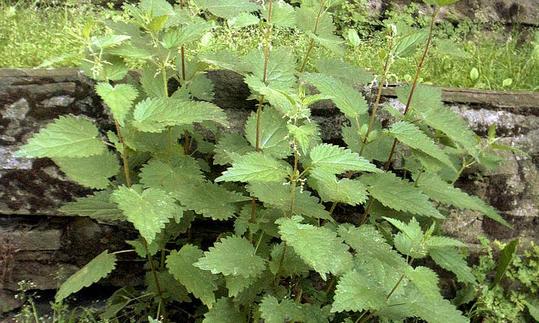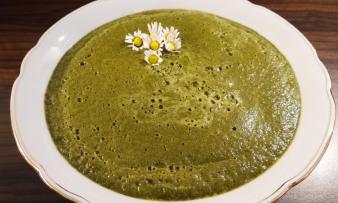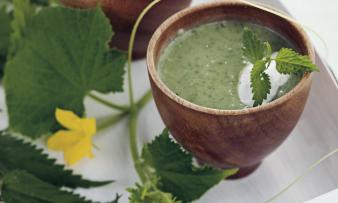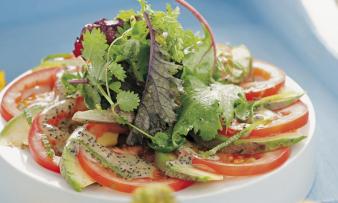Table of contents
The common nettle ( Urtica dioica) is reminiscent of raw hemp with its appearance and serrated leaf edges. This wild and medicinal plant is therefore also known as hemp nettle 15 (not to be confused with the stinging nettle species Siberian hemp nettle). Organic ?
Use in the kitchen
Nettles are a traditional wild vegetable. The basic taste of the leaves is very similar to that of spinach, but nettles are spicier. The aroma of hemp nettle harmonizes particularly well with dandelions, wild garlic or sorrel.
Can you eat the stinging nettle raw? Raw leaves and stems of the stinging nettle are very irritating, hence the alternative name "stinging nettle" (but the small stinging nettle stings even more 5). Options for eliminating the stinging effect include drying, watering and cooking the plant parts, as well as mechanical processing by kneading or rolling, mixing or juicing.
Young shoots (April-June) can be processed in many different ways: in patties, chopped herb mixtures, sauces, as 'sauerkraut' or 'spinach'. Steamed, they taste great as wild vegetables or pizza toppings, in puree, polenta, risotto, spaetzle or soup, as well as in fillings for lasagne, nettle tart, strudel or vegetable pockets. The leaves can be used raw as a basis for wild herb smoothies, raw vegetable juices, pestos, salads, and to flavor drinks, oils or vinegar. Dried and powdered, the large nettle tastes great in wild plant salt or spice mixtures.
Older leaves increasingly form calcium oxalate crystals. Therefore, from mid-summer onwards, they should preferably only be used blanched and the cooking water discarded. Small amounts can be eaten dried or very finely chopped as a seasoning herb.
The raw seeds (July-October) have a subtle nutty taste and are used as sprouting seeds or as an ingredient in dough. The flowers can be processed in a similar way to the leaves. They are particularly good in chutneys, brewed as tea or in vegan wild plant butter.
Vegan recipe for hemp nettle spinach
Ingredients (for 2 people): 300 g young nettle leaves (raw), without stems (wild or organic quality); 1 wild garlic bulb, diced; 2 tbsp vegan sour cream (organic); salt ;pepper ; nutmeg ; 1-2 tsp flour.
Preparation: Blanch older leaves for around 3 minutes together with the wild garlic bulb. Pour away the cooking water because of the dissolved oxalic acid and add a little fresh water. If the leaf shoots are very young, you can keep the nutrient-rich blanching water. Now puree the wild vegetables with the vegan sour cream and season with salt, pepper and nutmeg. If necessary, you can thicken the vegan wild plant spinach with a little flour.
Recipe for (fresh) nettle tea
To make the tea, pour 250 ml of boiling water over two heaped teaspoons of dried organic leaves (nettle herb) and/or roots. After letting it brew for 5 minutes, strain the brew and drink the tea in moderately warm sips. It is recommended that you drink one cup of tea each morning and evening over a period of 4-8 weeks. 1 You can find another tea recipe HERE.
A proven tea mixture for a diuretic tea consists of 70 g of nettle herb and 30 g of birch leaves. 2
Vegan recipes with nettles can be found under the note: " Recipes that have the most of this ingredient ".
| Not only vegans or vegetarians should read this: Vegans often eat unhealthily. Avoidable nutritional mistakes. |
Shopping - Storage
Supermarkets such as Coop, Migros, Denner, Spar, Rewe, Edeka, Billa or Hofer as well as organic supermarkets such as Denn's Biomarkt and Alnatura often offer organic tea or tea blends with nettle leaves (nettle herb). We did not find any conventional or organic products containing nettles at supermarket chains such as Volg, Aldi and Lidl.
In pharmacies, drugstores, health food stores, organic shops or online, you can buy other products containing nettle herb (colloquially hemp nettle) in the food, natural cosmetics or health departments. Popular products include food supplements (capsules, extracts, dragees), freshly pressed plant juice, loose tea (also in raw quality), dried organic seeds and organic roots as well as natural cosmetics, e.g. hair soap, shampoo, hair tonic.
Where can you buy fresh stinging nettles (correctly: nettles)? The raw wild plants, known locally as Grosse Neddeln (large nettles), can be obtained with a little luck from a specialised greengrocer, at the weekly market, online or directly from the farmer, e.g. via a subscription box / seasonal box / green box.
The availability of the stinging nettle varies depending on the size of the store, catchment area, etc. Our recorded food prices for the DA-CH countries can be found above under the ingredient image - and by clicking on them you can see their development at various suppliers.
Found in the wild
Profile: Large stinging nettles are perennials with creeping, yellow roots and mostly square stems. The egg-shaped, pointed, deeply toothed leaves, which are up to 8 cm long, are arranged in pairs on the stem. The tiny, green summer flowers emerge from the leaf axils and hang down in panicles. The height of the hardy plant depends on the location. On average it is around 1.5 m, 3.4 in contrast to the small stinging nettle ( Urtica urens), which grows to around 45 cm tall and stings much more strongly. 5
When does the common nettle flower? Season: The flowering period is between May/June and October. 1,3,4 From May to August you can collect the shoots and leaves of wild nettle young plants. In spring or autumn you dig up the roots. 1
Is hemp nettle a weed? Hemp nettles are a well-known weed that thrives in nutrient-rich herbaceous areas. They can be found near human dwellings, in gardens, on fences, on the edges of ditches, on rubble heaps and on wasteland. 1
Storage tips
Freshly picked nettles can be stored in a cool, airy place for a few days, e.g. in a linen bag or basket. Carefully dried leaves can be stored for several months in a dark glass jar or metal tin, dry and protected from light.
Ingredients - Nutritional values - Calories
100 g of large nettles (raw) have a calorie content of 42 kcal, 0.11 g fat, 7.5 g carbohydrates (of which 6.9 g fiber) and 2.7 g protein.
The wild plant contains a lot of vitamin K (499 µg/100g). Even more can be found in raw chard (830 µg), raw dandelion leaves (778 µg), raw kale (705 µg) and raw garden cress (542 µg vitamin K per 100 g).
The high calcium content (481 mg/100g) makes nettle leaves a better source of calcium than fresh herbs such as thyme (405 mg), cow parsley (400 mg) or fenugreek leaves (328 mg/100g). 6,7
The frequent claim that the chlorophyll content is particularly high compared to other medicinal plants could not be confirmed. 9
The roots contain lectins, sterols, coumarins, lignans and fatty acids. 4 In addition, a specific lectin, the so-called ' Urtica dioica agglutinin', is found exclusively in the root. 10 The stinging juice contained in the stinging hairs consists of small amounts of acetylcholine, serotonin, formic acid and histamine. 9,10
In addition to about 30% oil (mainly linoleic acid), the seeds also contain mucilage, carotenoids and a vitamin E content of up to 0.1%. 4
Are there tables for the ingredients of nettle?
The complete ingredients of the stinging nettle, the coverage of the daily requirement and comparison values with other ingredients can be found in our nutrient tables. In the article Nutrients explained you will get a detailed insight into the topic.
Health effects
The health effects of the large and small nettles are considered to be comparable, although a 2017 study attributes greater antioxidant activity to the large nettle. 8
The diuretic effect of the nettle plant, also known as goutweed, is based on its high mineral content (especially potassium). It leads to increased water excretion via the kidneys. This creates an osmotic effect, which, however, only comes into effect in combination with a sufficient water intake. 11
The nettle has an immunomodulating and anti-inflammatory effect. Certain ingredients influence the metabolism and have a positive effect on chronic inflammatory processes. 11,21
The effectiveness of root extract in benign prostatic hyperplasia (enlarged prostate) has been one of the best-researched indications since 2007. 12 As with all herbal prostate remedies, the therapeutic effect is primarily based on improving symptoms and not on reducing the size of the prostate. 21 A doctor should monitor the course of the underlying disease at regular intervals. The roots are suitable for long-term use. Mild gastrointestinal complaints can occasionally occur. 11
Skin contact with raw hemp nettle has a subsequent pain-relieving effect. 13,21 It is believed that this is due to an increased blood flow to pain nerves through serotonin and other ingredients in the stinging hairs. The stinging, burning sensation of a nettle sting lasts for several minutes. Within 30 minutes, a warm tingling sensation develops that lasts for 12-24 hours. 13
Secondary plant substances
Many of the health effects of the stinging nettle can be attributed to the secondary plant substances it contains. Our article on secondary plant substances provides an overview of the classification of the substance groups, their occurrence in foods and possible effects on humans. The stinging nettle contains the following secondary plant substances:
Nettles contain about 1-2% flavonoids. 9 Laboratory analyses show a total of 16 flavonoids as well as flavone and flavonol glycosides in the above-ground parts of the plant. 8 Other secondary ingredients are anthocyanins, 1-4% silicates, scopoletin, sitosterol, caffeic acid esters, polyphenols (particularly high in fresh leaves) and traces of nicotine. 9
Dangers - Intolerances - Side effects
Contact with fresh nettle herb causes burning stings (formic acid) and quickly subsiding, slight swelling. Alternative names such as sharp nettle, stinging nettle or brewing nettle are due to these plant properties. In rare cases, severe allergic reactions can occur. 12
There are no known significant adverse side effects or interactions associated with the internal use of nettle extract. 1,11,12 Seed extract may potentially affect the effects of concomitantly administered medications. 14
Edema due to reduced cardiac and renal function is known to be a contraindication. 1,11
Use as a recognized medicinal plant
All parts of the medicinal plant are used medicinally: (flowering) herb (Urticae herba), leaves (Urticae folium), roots (Urticae radix) and seeds (Urticae semen). Usually no distinction is made between the small and the large nettle. 11,15 The average daily dose is 8-12 g in preparations such as teas, extracts or preparations. 11
When using flushing therapy, it is important to ensure that the plant consumes sufficient fluids of at least 2 l/day. The plant stems must be no more than 3 mm thick, otherwise the leaves will contain too little of the ingredients that determine their effectiveness, especially potassium salts. These salts are only found in the leaf parts. Standardized ready-made medicines are preferable for serious treatment. 11
The HMPC ( Expert Committee of the European Medicines Agency) has classified Urtica dioica as a herbal medicine (trad. use). It can be used internally for mild aching limbs and to increase the amount of urine. It is therefore used to flush the urinary tract and to support mild urinary tract complaints. It is used externally to treat chronic inflammatory and scaly skin rashes, seborrhoeic dermatitis. 9
Another indication for treatment with the medicinal plant, based on recent clinical studies, is osteoarthritis. 11,21
Note: In the case of acute rheumatic complaints that are accompanied by redness, swelling or overheating, as well as in the case of persistent complaints, a doctor should be consulted. 9 In the case of degenerative joint diseases and kidney or gallstones, a treatment with nettle tea should be discussed with a specialist. 1
Folk medicine - natural healing
In folk medicine, tea and fresh plant juice are used - in addition to being used as a diuretic - for joint and muscle rheumatism, bile duct diseases, arthritis, for blood formation, increasing enzyme production in the pancreas and promoting wound healing. Externally, nettles are used to care for the scalp and hair - hence the alternative names hair nettle or hair root. 9
Ecological footprint - animal welfare
Even though there are hardly any figures on the ecological footprint of the nettle, one can generally assume that the nettle is a climate-friendly food.
A study compared the CO 2 footprint of nettles (without specifying the subspecies) with their nutritional value. To cover a third of the daily macronutrient requirement with nettles, one would have to eat 800 g of them (just a theoretical assumption). This portion would produce 138 g of CO 2, which corresponds to 0.173 kg CO 2 eq/kg. Only a few foods, such as butternut squash (0.086 kg CO 2 eq/kg), cause a smaller footprint. 22 Carrots (0.1 kg CO 2 /kg) and fresh spinach (0.2 kg CO 2 /kg) have a similarly small footprint. In general, unprocessed, plant-based foods have a very good carbon footprint. Exceptions are, for example, vegetables and fruit imported by plane. Animal products have a larger footprint of 1.1 kg CO 2 eq/kg (milk) to 21 kg CO 2 eq/kg (average beef). 27
Despite extensive research, we were unable to find any specific data on the water footprint of stinging nettles. Perhaps the water footprint of the common nettle could be compared with that of spinach. Spinach has a global average water footprint of 292 l/kg. This is below the average for vegetables – so it has a small footprint. 26 From our own experience (cultivation in Central Europe), however, nettles need far less water than spinach. In the literature, however, nettles are also classified as water-intensive crops; however, data on water requirements and water use efficiency are very scarce. In some cases, nettles may need to be irrigated. Nettles can survive without irrigation in summer rainfall of 56 mm. 23 Of course, a plant's water consumption depends on various factors, including the cultivation system, climate and irrigation methods. Wild nettles usually get by with relatively little water.
For detailed explanations of various sustainability indicators (such as ecological footprint, CO2 footprint, water footprint), see our article: What does the ecological footprint mean?
Animal protection - species protection
Stinging nettles are important food plants for numerous butterfly caterpillars, 20 for example for the spotted nettle bug. The caterpillars of the small tortoiseshell and the peacock butterfly are monophagous, meaning they feed almost exclusively on them. The roots serve as food for the large hop rootworm.
Researchers have investigated the potential of the common nettle as a crop. In addition to the many uses of the plant, it also offers environmental benefits. The cultivation and propagation of the plant using biological methods works particularly well. The common nettle also promotes biodiversity by serving as a food plant and as a habitat for beneficial insects. 23,24 As already mentioned: nettles ( Urtica dioica and Urtica urens) are food and nesting plants for a variety of butterflies. 25
The common nettle is an undesirable weed in intensive agricultural systems. As a fast-growing, undemanding and vegetatively propagating plant, the common nettle can quickly take over large areas. However, there are economic and ecological reasons for consciously cultivating the common nettle. As a perennial and undemanding plant, you can expect good yields for 15 years in an ideal scenario. Over-fertilized fields could benefit from the cultivation of this crop and at the same time promote the biodiversity of the local fauna and flora. The common nettle as an agricultural product has a wide variety of sales markets: as food, for textiles or even in the energy sector. 23
Worldwide occurrence - cultivation
The hemp nettle grows as a weed in temperate zones in the northern hemisphere, almost everywhere as a companion to humans. 2,16 The wild plants show a strong association with nitrogen-enriched places where humans and animals live. Nutrient inputs and drainage of riparian forests strongly promoted growth, especially in the edge areas of forests. 17,18
Plants for medicinal use come mainly from wild sources in Central and Eastern Europe, including Bulgaria. 5.9
Growing in the garden or as a pot plant
The stinging nettle can be grown in moist, nitrogen-rich soil in a sunny spot in the garden or in a pot. Cutting back the plants in summer encourages a second growth. Digging up rhizomes can limit the plants' rapid spread. Propagation is done by dividing the rhizomes or sowing in spring. 3
Cultivation - Harvest
Annual or perennial plants are grown for commercial cultivation. In May, sowing or planting of rhizomes or early young plants takes place outdoors. The leaves are harvested with cutter loaders during full bloom between August and October. The yield per hectare of cultivated area is 20 to 40 tons of wet mass or 2.5 to 4 tons of medicinal plants (medicinal herbs). 19
Further information
The common stinging nettle ( Urtica dioica) is one of 30-70 species in the genus of nettles ( Urtica). It belongs to the nettle family (Urticaceae). Urtica is derived from the Latin urere (to burn, to burn) and refers to the injuries caused by the stinging hairs. 3,21 The fruits spread in many different ways as balloons or winged flyers, floaters or clinging to animal fur. 17
Are hemp and stinging nettle related to each other? Although hemp ( Cannabis) and common nettle both belong to the rose family (order: Rosales), they are not closely related. The common name hemp nettle is based on visual similarities. However, it does not only refer to the common nettle, but can also refer to the common stinging nettle ( Galeopsis tetrahit). This must be distinguished from the official name Siberian hemp nettle ( Urtica cannabina) (also called Siberian nettle, hemp nettle or hemp-leaved nettle).
Alternative names
Alternative names include Urtica major, Urtica urens maxima, Stinging nettle, hemp nettle, nettle, nettle herb, thousand nettle, large (large) nettle, large nettles, large nedels, nettle, nettle herb, este herb, essle (essle), thunder nettle, thunder nettle, thunder nettle, dunner nettle, fire herb, sharp nettle, sengnessel, senz nettle, bruh nettle, bitzele, hair nettle, hair root, gout rod, fiber nettle, saum nettle, habern nettle, tit-kölbl, bagpiper, zingel, tissel or devil's herb.
In earlier times, the nettle was dedicated to the Germanic god Thor, hence alternative names such as Donnernessel, Dunnernettel, Donnernettel or Donnernettl.
Incorrect spellings are large nettle, large stinging nettle, hemp nettle or Urtica doica. The following misspellings are common, but were previously correct: nettle flowering time, nettle nutritional values, nettle plant, etc.
In English, the stinging nettle is called common nettle or stinging or burn nettle and the herb is called nettle herb or nettle leaf.
Other uses
The fiber nettle, a convariety of Urtica dioica, was an important fiber plant for the production of strong fabrics, nets or ropes until the 18th century because of its bast fibers. The modern term nettle fabric (organic), however, refers to a canvas fabric made of cotton.
Bibliography - 27 Sources
| 1. | Pahlow M. Das grosse Buch der Heilpflanzen. Gesund durch die Heilkräfte der Natur. Hamburg: Nikol Verlagsgesellschaft mbH & Co. KG; 8. Auflage. 2019. |
| 2. | Niederegger O, Mayr C. Heilpflanzen der Alpen. Gesundheit aus der Natur von A bis Z. Innsbruck: Tyrolia-Verlag; 2006. |
| 3. | Bown D. Kräuter. Die grosse Enzyklopädie. Anbau und Verwendung. München: Dorling Kindersly; 2. Auflage. 2015. |
| 4. | Fleischhauer SG, Guthmann J, Spiegelberger R. Enzyklopädie. Essbare Wildpflanzen. 2000 Pflanzen Mitteleuropas. Aarau: AT Verlag; 1. Auflage. 2013. |
| 5. | Dr. Gerhard I, von Ganski N. Die neue Pflanzenheilkunde für Frauen. München: Verlag Zabert Sandmann GmbH; 1. Auflage. 2011. |
| 6. | USDA (United States Department of Agriculture). Nährstofftabellen. |
| 7. | Diet-Health.info Nährstofftabellen. |
| 8. | Carvalho AR, Costa G, Figueirinha A et al. Urtica spp.: Phenolic composition, safety, antioxidant and anti-inflammatory activities. Food Res Int. 2017;99(Pt 1):485-494. |
| 9. | Blaschek W. (Hrsg.). Wichtl –Teedrogen und Phytopharmaka. Ein Handbuch für die Praxis. Stuttgart: Wissenschaftliche Verlagsgesellschaft mbH; 6. Auflage. 2016. |
| 10. | Heyland K-U, Hanus H, Keller ER (Hrsg.). Handbuch des Pflanzenbaues. Ölfrüchte, Faserpflanzen, Arzneipflanzen und Sonderkulturen. Stuttgart: Eugen Ulmer-Verlag; 2006. |
| 11. | Schilcher H, Kammerer S, Wegener T. Leitfaden Phytotherapie. München: Elsevier GmbH; 3. Auflage. 2007. |
| 12. | Authors ns. Urtica dioica, Urtica urens (nettle). Altern Med Rev. 2007 Sep;12(3):280-284. |
| 13. | Pirker A. Pharmakologie – die Schnittstelle zwischen klassisch orientierter Humanmedizin und der Naturheilkunde – eine Extraktion ausgewählter potenter Heilpflanzen. Graz; 2014. |
| 14. | Agus HH, Tekin P et al. Drug interaction potential of the seed extract of Urtica urens L. (dwarf nettle). Phytother Res. 2009;23(12):1763-1770. |
| 15. | Arzneipflanzenlexikon.info Brennnessel. |
| 16. | Jiarui C, Friis IB, Wilmot-Dear CM. Urtica. In: Zhengyi WU, Raven PH, Hong D (Hrsg.). Flora of China. Volume 5. Ulmaceae through Basellaceae. Beijing/St. Louis: Science Press/Missouri Botanical Garden Press; 2003. |
| 17. | Düll R, Kutzelnigg H. Taschenlexikon der Pflanzen Deutschlands. Ein botanisch-ökologischer Exkursionsbegleiter zu den wichtigsten Arten. Wiebelsheim; Quelle & Meyer; 2005. |
| 18. | Dörr E, Lippert W. Flora des Allgäus und seiner Umgebung. Band 1. Eching: IHW; 2001. |
| 19. | Heyland K-U (Hrsg.). Spezieller Pflanzenbau. Stuttgart: Eugen Ulmer; 1996. |
| 20. | Robinson GS, Ackery PR, Kitching IJ et al. HOSTS – a Database of the World's Lepidopteran Hostplants. |
| 21. | Dhouibi R, Ksouda K, Ben Salem M et al. Screening of pharmacological uses of Urtica dioica and others benefits. Progress in Biophysics and Molecular Biology. 2020 Jan;150: 67-77. |
| 22. | Greenpeace Schweiz, Stadt Zürich, Planted Foods AG, Branding Cuisine, Tinkerbelle, Inge, myblueplanet, ProVeg International, Dr. Earth, FightBack und Eaternity. All You Can Eatfor climate - Poster. ayce.earth. 2022. |
| 23. | Di Virgilio N, Papazoglou EG et al. The potential of stinging nettle (Urtica dioica L.) as a crop with multiple uses. Industrial Crops and Products. 2015;68:42–49. |
| 24. | James DG, Lauby G et al. Beneficial insects associated with stinging nettle, Urtica dioica Linnaeus, in central Washington State. Pan-Pacific Entomologist. 2015;91(1):82–90. |
| 25. | Heistinger A, NOAH VA. Handbuch Bio-Balkongarten: Gemüse, Obst und Kräuter auf kleiner Fläche ernten. Löwenzahn Verlag; 2020. 482 S. |
| 26. | Mekonnen MM, Hoekstra AY. The green, blue and grey water footprint of crops and derived crop products. Hydrol Earth Syst Sci. 25. Mai 2011;15(5):1577–1600. |
| 27. | Reinhardt G, Gärtner S, Wagner T. Ökologische Fussabdrücke von Lebensmitteln und Gerichten in Deutschland. IFEU Institut für Energie und Umweltforschung Heidelberg. 2020. |











Comments